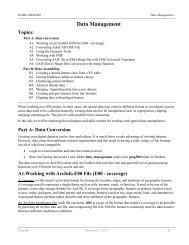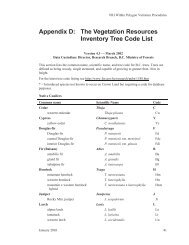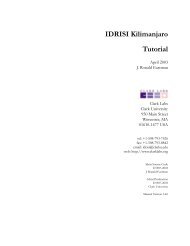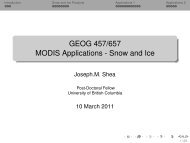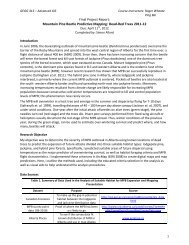Understanding Map Projections
Understanding Map Projections
Understanding Map Projections
You also want an ePaper? Increase the reach of your titles
YUMPU automatically turns print PDFs into web optimized ePapers that Google loves.
MILLER CYLINDRICAL<br />
Direction<br />
Local angles are correct only along the equator.<br />
Distance<br />
Correct distance is measured along the equator.<br />
LIMITATIONS<br />
Useful only as a world map.<br />
USES AND APPLICATIONS<br />
General-purpose world maps.<br />
The central meridian is 118° W.<br />
DESCRIPTION<br />
This projection is similar to the Mercator projection<br />
except that the polar regions are not as areally<br />
distorted. Spacing between lines of latitude as they<br />
approach the poles is less than in the Mercator<br />
projection. It decreases the distortion in area, but the<br />
compromise introduces distortion in local shape and<br />
direction.<br />
PROJECTION METHOD<br />
Cylindrical projection. Meridians are parallel and<br />
equally spaced, lines of latitude are parallel, and the<br />
distance between them increases toward the poles.<br />
Both poles are represented as straight lines.<br />
LINE OF CONTACT<br />
The equator.<br />
LINEAR GRATICULES<br />
All meridians and all parallels.<br />
PROPERTIES<br />
Shape<br />
Minimally distorted between 45th parallels,<br />
increasingly toward the poles. Land masses are<br />
stretched more east–west than they are north–south.<br />
Area<br />
Distortion increases from the equator toward the<br />
poles.<br />
Supported map projections• 71




